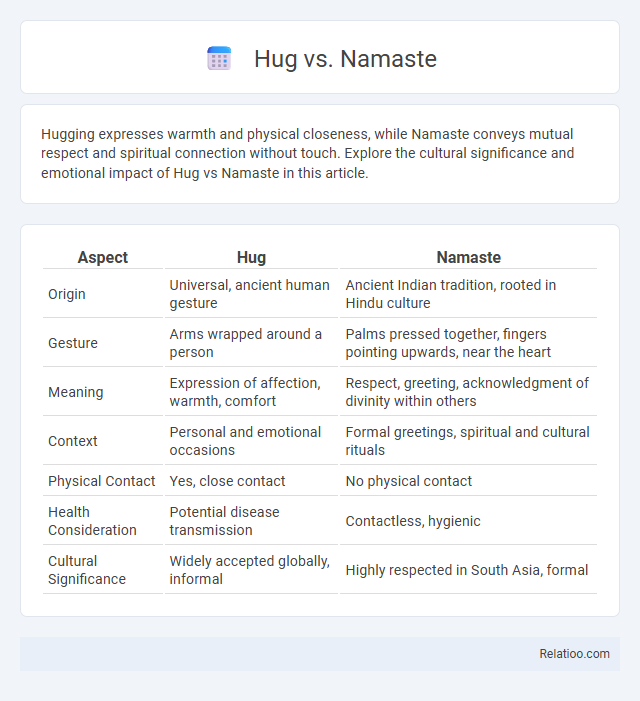Hugging expresses warmth and physical closeness, while Namaste conveys mutual respect and spiritual connection without touch. Explore the cultural significance and emotional impact of Hug vs Namaste in this article.
Table of Comparison
| Aspect | Hug | Namaste |
|---|---|---|
| Origin | Universal, ancient human gesture | Ancient Indian tradition, rooted in Hindu culture |
| Gesture | Arms wrapped around a person | Palms pressed together, fingers pointing upwards, near the heart |
| Meaning | Expression of affection, warmth, comfort | Respect, greeting, acknowledgment of divinity within others |
| Context | Personal and emotional occasions | Formal greetings, spiritual and cultural rituals |
| Physical Contact | Yes, close contact | No physical contact |
| Health Consideration | Potential disease transmission | Contactless, hygienic |
| Cultural Significance | Widely accepted globally, informal | Highly respected in South Asia, formal |
Understanding Hug and Namaste: A Cultural Overview
Hug and Namaste represent two distinct cultural expressions of greeting and respect, with hugs being a common physical embrace widely practiced in Western cultures to convey warmth and affection. Namaste, originating from Indian traditions, involves a respectful gesture with palms pressed together and a slight bow, symbolizing honor and the belief in the divine within each person. Understanding these gestures highlights the cultural nuances in human connection, emphasizing physical closeness in hugs versus spiritual acknowledgment in Namaste.
The Origins and History of Hugging
Hugging, a universal gesture of affection and comfort, traces its origins back to ancient civilizations where it symbolized unity and protection, notably in Mesopotamian and Egyptian cultures. Namaste, rooted in Indian tradition, emerges from the Sanskrit word meaning "I bow to you," reflecting deep spiritual respect and recognition of the divine in others. Understanding these distinct yet meaningful gestures enriches your appreciation of human connection across diverse cultural histories.
The Significance of Namaste in Eastern Traditions
Namaste, a traditional gesture in Eastern cultures, symbolizes respect, humility, and the recognition of the divine within others, differing fundamentally from the physical embrace of a hug. Rooted in Hinduism, Buddhism, and Jainism, Namaste involves pressing the palms together at the heart center and bowing slightly, reflecting spiritual significance beyond mere physical contact. Understanding this practice enriches your appreciation of Eastern social customs and highlights the deep cultural reverence embedded in greeting rituals.
Body Language: Hug vs Namaste
Hug and Namaste are distinct body language gestures conveying warmth and respect, respectively. A hug involves embracing with open arms, signaling closeness, affection, and comfort, while Namaste is performed by pressing palms together in front of the chest, symbolizing reverence and greeting without physical contact. Your choice between a hug and Namaste communicates different levels of emotional connection and cultural sensitivity in social interactions.
Emotional Impact: Experiencing Connection Differently
Hug, Namaste, and handshake each create unique emotional connections influenced by cultural context and intent. A hug conveys warmth and physical closeness, fostering immediate emotional bonding through touch, while Namaste, a gesture of respect and spiritual recognition, offers a deeper, more mindful connection without physical contact. Your choice among these gestures shapes the emotional experience, balancing intimacy and cultural sensitivity.
Health Benefits: Physical and Psychological Effects
Hugging stimulates the release of oxytocin, a hormone that reduces stress, lowers blood pressure, and boosts immune function, providing significant physical health benefits. Namaste, a traditional Indian greeting involving a gesture of hands pressed together, promotes mindfulness and a sense of calm, enhancing psychological well-being by reducing anxiety and fostering emotional balance. Combining both gestures can synergistically improve mental resilience and physical health by integrating tactile comfort from hugs with the meditative, respectful energy of Namaste.
Social Etiquette: When to Hug, When to Namaste
Hugs are commonly used in Western cultures as a warm, physical gesture of affection or greeting among close friends and family, typically in informal or intimate settings. Namaste, rooted in Indian tradition, serves as a respectful, non-contact greeting appropriate in formal, professional, or religious contexts and gains prominence during health concerns such as pandemics. Choosing between a hug and a namaste depends on cultural norms, personal comfort levels, and the situational context, ensuring respect for boundaries and social etiquette.
Cross-Cultural Comparisons and Adaptations
Hug, Namaste, and High Five each represent distinct cultural expressions of greeting and connection with unique social meanings. Hug is a universally recognized gesture conveying warmth, comfort, and intimacy, commonly used in Western cultures and increasingly adopted worldwide. Your understanding of when to use Namaste--an Indian gesture symbolizing respect and spiritual acknowledgment--versus a Hug or High Five is crucial for fostering respectful and appropriate cross-cultural communication.
The Role of Pandemic in Shifting Greetings
The COVID-19 pandemic significantly altered social greetings, shifting preferences from physical touches like hugs to non-contact gestures such as namaste, which promotes hygiene and reduces virus transmission. Public health guidelines emphasized social distancing, making traditional hugs less acceptable in many cultures, while namaste gained global recognition as a respectful, virus-safe alternative. This shift reflects a growing awareness of health-conscious interactions and the adaptability of cultural practices in response to public health crises.
Choosing Respectful Greetings in a Globalized World
Choosing respectful greetings in a globalized world requires understanding cultural nuances between gestures like Hug, Namaste, and other forms of embrace. Hugging is a common expression of warmth in Western cultures but may be intrusive in regions valuing personal space and formality, where Namaste--a gesture involving pressed palms and a slight bow--serves as a respectful alternative. Adapting greeting styles based on cultural context promotes inclusivity and mutual respect in international interactions.

Infographic: Hug vs Namaste
 relatioo.com
relatioo.com